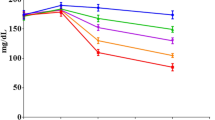Abstract
The aim of the present study was to determine if Cuscuta pedicellata extract has an effect on body weight and serum lipid profile in the HFD-fed rats’ animal model. The ethanol extract of C. pedicellata exhibited a significant reduction in body weight and serum lipid profile in this model. The n-hexane/EtOAc (1:1), EtOAc and MeOH/EtOAc (1:1) fractions were also active, while the MeOH fraction showed no beneficial effect. Bioactivity-guided fractionation leads to the isolation of ten pure compounds: naringenin (1), kaempferol (2), aromadenderin (3), quercitin (4), 3,5,7,3′,5′-pentahydroxy flavanone (5), naringenin -7-O-β-d-glucoside (6), aromadenderin -7-O-β-d-glucoside (7), Taxifolin -7-O-β-d-glucoside (8), kaempferol -3-O-β-d-glucoside (astragalin), (9) and quercitin -3-O-β-d-glucoside (isoquercitrin) (10). This is the first report of compounds 1, 3, 5, 6, 7, and 8 in Cuscuta pedicellata. Compound 1 > compound 8 > compound 3 > compound 7 > compound 4 > compound 2 are responsible for the potency of the ethanol extract, while compound 6 was only effective in reducing the total cholesterol serum levels but not effective in reducing the level of triglycerides or the body weight. Our data confirmed the anti-obesity effect of C. pedicellata reported by the Egyptian population and identified the compounds responsible for this activity.



Similar content being viewed by others
References
Al-Hallaq EK, Kasabri V, Abdalla SS, Bustanji YK, Afifi FU (2013) Anti-obesity and antihyperglycemic effects of Crataegus aronia extracts: in vitro and in vivo evaluations. Food Nutr Sci 4:972–983
Baek SW, Kim ER, Kim J, Kim YC (2011) Chemical constituents of Abies koreana leaves with inhibitory activity against nitric oxide production in bv2 microglia cells. Nat Prod Sci 17:175–180
Bakhai MN, Tirgar PR (2013) In-vivo investigation of antiobesity activity of polyherbal formulation. IntJ Res Pharm Biomed Sci (IJRPBS) 4:1095–1103
Campfield LA, Smith FJ, Burn P (1998) Strategies and potential molecular targets for obesity treatment. Science 280:1383–1387
Costea M (2007) Digital atlas of cuscuta (convolvulaceae). Wilfrid Laurier University Herbarium, Ottawa, pp 884–1970
Elberry AA, Harraz FM, Ghareib SA, Gaber SA, Nagy AA, Abdel-Sattar E (2011) Methanolic extract of Marrubium vulgare ameliorates hyperglycemia and dyslipidemia in streptozotocin-induced diabetic rats. Int J Diabetes Mellit 10:1016
Glenny AM, OˇıMeara S, Melville A, Sheldon TA, Wilson C (1997) The treatment and prevention of obesity: a systematic review of the literature. Int J Obes 21:715–737
Gödecke T, Kaloga M, Kolodziej H (2005) A phenol glucoside, uncommon coumarins and flavonoids from Pelargonium sidoides DC. Z Naturforsch 60b:677–682
Jain R, Mittal M (2012) Naringenin, a flavonone from the stem of Nyctanthes arbortristis linn. Int J Biol Pharm Allied Sciences (IJBPAS) 1:964–972
John V, Peter St, Billington CJ (2008) Pharmacotherapy : A Pathophysiologic approach, 7th edn. McGraw-Hill Professional, New York, pp 2437–2451
Katz M (2006) Study Design and statistical analysis: a practical guide for clinicians. Cambridge University Press, London 155
Kazuma K, Noda N, Suzuki M (2003) Malonylated flavonol glycosides from the petals of Clitoria ternatea. Phytochemistry 62:229–237
Knekt P, Kumpulainen J, Järvinen R, Rissanen H, Heliövaara M, Reunanen A, Hakulinen T, Aromaa A (2002) Flavonoid intake and risk of chronic diseases. Am J Clin Nutr 76:560–568
Lee I, Bae J, Kim T, Kwon J, Kim T (2011) Polyphenolic constituents from the aerial parts of thymus quinquecostatus var. japonica collected on Ulleung Island. J Korean Soc Appl Biol Chem 54:811–816
Li H, Hong-Zheng F (2009) Chemical constituents from fruits of Gymnocladus chinensis. Chin Herb Med 1:66–70
Mnafgui K, Hamden K, Ben Salah H, Kchaou M, Nasri M, Slama S, Derbali F, Allouche N, Elfeki A (2012) Inhibitory activities of zygophyllum album: a natural weight-lowering plant on key enzymes in high-fat diet fed rats. Evid Based Complement Alternat Med 2012:620384. doi:10.1155/2012/620384
Mukhtar I, Khokhar I, Mushtaq S (2012) Cuscuta pedicellata (Convolvulaceae): a new parasitic weed recorded from Pakistan. Pak J Weed Sci Res 18:485–493
Ohta Y, Sami M, Kanda T, Saito K, Osada K, Kata H (2006) Gene expression analysis of the anti-obesity effect by apple polyphenols in rats fed a high fat diet or a normal diet. J Oleo Sci 55:305–314
Park H, Kim H, Jeon S, Kim S, Chun W, Lim S, Kim M, Kwon Y (2009) Aldose reductase inhibitors from the leaves of Salix hulteni. J Korean Soc Appl Biol Chem 52:493–497
Pi-Sunyer FX (2002) The obesity epidemic: pathophysiology and consequences of obesity. Obesity 10:97S–104S
Reed MJ, Meszaros K, Entes LJ, Claypool MD, Pinkett JG, Gadbois TM, Reaven GM (2000) A new rat model of type 2 diabetes: the fat-fed, streptozotocin-treated rat. Metabolism 49:1390–1394
Song N, Xu W, Guan H, Liu X, Wang Y, Nie X (2007) Several flavonoids from Capsella bursa-pastoris (L.) Medic. Asian J Tradit Med 2:218–222
Srinivasan K, Patole PS, Kaul CL, Ramarao P (2004) Reversal of glucose intolerance by PIO in high-fat diet fed rats. Methods Find Exp Clin Pharmacol 26:327–333
Täckholm V (1974) Students’ flora of Egypt, 2nd edn. Cairo University Press, Cairo
Zheng CD, Duan YQ, Gao JM, Ruan ZG (2010) Screening for anti-lipase properties of 37 traditional chinese medicinal herbs. J Chin Med Assoc 73:319–324
Acknowledgments
The authors are grateful to Prof. Dr. Abd Elraof A., Professor of Botany, Faculty of Science, Suez Canal University for taxonomical identification of the plant.
Author information
Authors and Affiliations
Corresponding author
Electronic supplementary material
Below is the link to the electronic supplementary material.
Rights and permissions
About this article
Cite this article
Zekry, S.H., Abo-elmatty, D.M., Zayed, R.A. et al. Effect of metabolites isolated from Cuscuta pedicellata on high fat diet-fed rats. Med Chem Res 24, 1964–1973 (2015). https://doi.org/10.1007/s00044-014-1269-5
Received:
Accepted:
Published:
Issue Date:
DOI: https://doi.org/10.1007/s00044-014-1269-5




